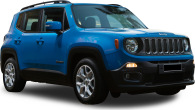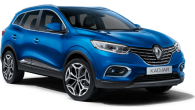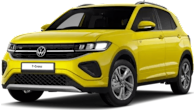You know what’s confusing? When a Toyota doesn’t sell that well in Australia. The brand has been on top of the charts for 16 years straight, and it sells most of its models in big numbers.
The Toyota Fortuner, then, is a bit of a perplexing case study. It wasn’t even in Toyota’s top-10 best sellers for 2018, and was easily outsold by main rivals like the Isuzu MU-X, Ford Everest and Mitsubishi Pajero Sport. And with new, lesser-known arrivals like the SsangYong Rexton and LDV D90 arguing very strong cases on cost, the Fortuner is at risk of falling even further behind.
So, let’s figure out where the Fortuner stacks up, what it does well, and how it could be improved.
Toyota Fortuner 2019: GX
| Engine Type | Diesel Turbo 4, 2.8L |
|---|---|
| Fuel Type | Diesel |
| Fuel Efficiency | 8.6L/100km (combined) |
| Seating | 7 |
| Price From | $32,670 - $38,940 |
| Safety Rating |
|
Is there anything interesting about its design?
6 / 10
You mightn’t be able to tell that the Fortuner is based on the HiLux ute (as the MU-X is based on the D-Max, Everest is based on the Ranger, and so on…), and that could be good or bad, depending on your take on things.
Where the HiLux looks a bit more muscled and edgy, the Fortuner is aimed to appeal more to those who appreciate curves and sweeping lines. To my eye, it doesn’t quite work.
The model you see in the images is the GX, which misses out on the privacy glass (tinted windows) offered on the models above, and likewise lacks roof rails (which make fitting roof racks a cinch), and it has colour-coded door handles, rather than chrome - there’s no chrome on the grille or rear door garnish, either. There are no fog lights, no daytime running lights, and the headlights are halogen units. Yeah, so it looks a bit… like a base model.
You still get side steps - which were put to good use by my niece and nephew, and my mum (she’s only 149cm) - and there’s a rear spoiler. Hey, if you want a full body kit, Thailand has some eBay sellers you should check out.
Sadly, Toyota decided that all Fortuner models should come with alloy wheels, so the 17s fitted to this model (and the GXL above it) have a little bit of bling about them, but not as much ‘go anywhere’ cred as earlier base models, which were fitted with black steel wheels.
.jpg)
How practical is the space inside?
6 / 10
With seven seats as standard, the Fortuner offers a more affordable alternative to the Prado above it, and a more hardcore option if you’d prefer to get dirtier than is possible in a Kluger.
It isn’t as roomy as either of those models, though, because the cabin space is compromised by the ladder-frame chassis and a poorly designed seven-seat layout. The rearmost seats never allow you to make full use of the entire width of the boot because they fold up into the D-pillars - and in the process, you can bank on any over-shoulder vision being cancelled out completely.
.jpg)
Make sure you clip those seats in and tighten the straps, as we had them fall down on occasion, such is the sharpness of the the suspension. Just imagine if you had something fragile (or, worse, a pet or a child's limb) under the seat when that happened...?
You won’t get the best boot space in the Fortuner. There’s 200 litres of cargo room with the third row seats in place, and that apparently jumps to 716L with the third row clipped up. The space expands to 1080L if you fold the second row seats forward.
The 60:40 second-row seats have a flip and tumble trigger for both sides (the larger portion is on the kerb side) and they slide fore and aft to allow better space for those in the back row. You’ll need to make sure those in the front row don’t have their seats set too far back, otherwise the second-row tumble function won’t work as the headrests will hit the seat backs in front.
During my time in the Fortuner I put all seven seats to use, so these criticisms come with a solid foundation. My eight-year old nephew and 12-year old niece fit in the back row just fine, and my mum, dad and sister could fit across the second row, but I wouldn’t use the word ‘comfortably’ to describe the experience. In fact, it was quite the opposite, as all five rear occupants complained about space, storage or comfort levels at some point. The ceiling-mounted centre belt was annoying, too - many other seven-seaters have the middle lap-sash belt built into the seat.
.jpg)
I even had a stint as second-row passenger on this test, and being 182cm tall, found it pretty unpleasant. I’m a good 15cm taller than the rest of my family, though, and they had no such issues with headroom.
.jpg)
Some good things to note, though - there is air conditioning for all three rows, with roof-mounted vents and a separate fan controller for the five back seats, and being a Toyota, the A/C is superb at cooling down a hot car very fast.
There are cup holders in a fold-down armrest in the second row, and some storage nooks in the third row but no cup receptacles. Also, the bottle holders are hard to access in the second row doors if you have three abreast.
Up front, the storage is okay but not great, with a pair of cup holders, reasonable bottle holders in the doors, and a very handy twin glovebox - the top portion of which has cooling, and it works (it stopped some roadtrip chocolates from melting).
All the controls are logically laid out, but the 7.0-inch touchscreen media display is pretty average. Some of the buttons are small and hard to locate, there is no volume knob, you can’t connect to Bluetooth unless you’re at a standstill, and there’s no nav in this spec. Add to that the fact the Bluetooth was glitchy on test (dropping out/failing to reconnect at times) and there’s no Apple CarPlay or Android Auto, and you can see that the Fortuner is hardly a class-leader for cabin comfort and convenience.
.jpg)
Does it represent good value for the price? What features does it come with?
6 / 10
The Fortuner GX is the opening gambit in the line-up, starting at $44,590 plus on-road costs. As a seven-seat AWD diesel auto, and as something of a hardcore SUV, that makes this grade a bit of a bargain, as it undercuts like-minded competitors by at least three grand. And it’s about five grand less than when it launched.
This version lacks a bit of the bling that you get in the higher-spec versions (and what the competitors have, too), and likewise is pretty sparsely equipped inside.
Standard are 17-inch alloy wheels with a full-size spare, cruise control, auto headlights, retractable side mirrors, side steps, mudflaps, fabric trim (in a ghastly brown hue), the aforementioned media screen with one USB and auxiliary jack. The sound system has six speakers, the steering wheel is plastic (not leather-wrapped) and there’s no digital speedometer. Also, the key has a separate fob for locking and unlocking, which is something I haven’t seen since the 1990s.
.jpg)
Hardcore inclusions consist of a rear differential lock and a low-range transfer case (with 2H, 4H and 4L drive modes), and while you get hill start assist, this spec misses out on hill descent control.
You do get a reversing camera and rear parking sensors, but the safety kit is otherwise limited. See the safety section below for more info.
.jpg)
What are the key stats for the engine and transmission?
7 / 10
Under the bonnet of the Fortuner is a familiar 2.8-litre four-cylinder turbo-diesel engine - the same one used in the HiLux and Prado.
It produces 130kW of power (at 3400rpm) and 450Nm of torque (from 1600-2400rpm), and it has a six-speed automatic as standard. Those outputs are decent for the class, but it’s not the best engine out there…
.jpg)
Towing capacity for the Fortuner is rated at 750 kilograms for a trailer without brakes, and up to 2800kg for a braked trailer. All of its diesel rivals offer better towing capacity.
How much fuel does it consume?
6 / 10
The diesel fuel use claim for the Fortuner is 8.6 litres per 100 kilometres, and you can bank on using more than that in pretty much all situations.
Over more than 1300km of driving over the Christmas/New Year period I saw no better than 10.0L/100km, with a mix of country, highway, city and back road driving, and between one and seven people on board.
A new addition for 2019 models is a diesel particulate filter (DPF) burn-off switch that is designed to allow owners to perform their own burn-off sequence, rather than relying on the automated system (which has developed a reputation for problems, and could soon be subject to a class-action law suit).
What's it like to drive?
5 / 10
I know there are more convincing ute-based SUVs out there for similar money, so I have to admit my time behind the wheel of the Fortuner was sullied somewhat.
The engine felt underdone at times, revving harder than its outputs suggested it should, even with the Power mode engaged. The six-speed auto had some odd actions at times, upshifting too soon and even feeling a bit clunky on occasion.
But the transmission’s grade braking system (exhaust brake, essentially) worked well descending steep hills, allowing you to go easy on the actual brakes if you’re loaded up or doing a lengthy downhill run - it’s particularly handy when towing, though we didn’t get a chance to do that this time around.
The steering is true enough, and at higher speeds it is nicely responsive, even if there is a lot of wallow and body roll, but at urban pace it requires a bit of wrestling as it’s quite heavy.
The suspension is, I have to say, fierce. It is sharp, largely uncomfortable in town or on the open road, and it never settles as much as you might want it to. The front suspension is a copy and paste job from the HiLux, while the rear suspension is a five-link setup that should deliver a more pliant drive experience than it does.
According to my family, it’s unpleasant to be a passenger in. As mentioned above, every single occupant that I had in the car over the test period had a gripe with it, ranging from “it feels a bit gutless” (from an owner of a 2011 HiLux diesel manual) to “I don’t want to get back in there” from the middle-seat passenger second-row passenger. “Why is it so bumpy?” was a common refrain, too.
I’ve driven the Fortuner in some serious terrain in the past, and I know it does quite an impressive job in that environment. This time around the extent of my off-road review was a few sections of unsealed gravel road, where there was barely any noticeable difference in terms of dynamic behaviour. It was still firm and not very comfortable, but the way the suspension behaved over washed out sections of road and big, open potholes was adequate.
If you're interested in the off-road specs of the Fortuner, here they are: approach angle - 30 degrees; departure angle - 25deg; break-over angle - 23.5deg; ground clearance - 225mm (not 279mm as Toyota originally stated); wading depth - 700mm; tare weight - 2095kg.
I’ll give it this, though - the Fortuner is relatively quiet. There’s not much road noise, and the diesel engine is louder outside than in. Some competitors can’t claim that.
Warranty & Safety Rating
What safety equipment is fitted? What safety rating?
6 / 10
The Toyota Fortuner scored the maximum five-star ANCAP crash-test rating when it was tested back in 2015, but the criteria for that score has changed over the years, and the Fortuner is lagging behind when it comes to safety equipment.
Sure, every model comes with a reversing camera, rear parking sensors, seven airbags (dual front, front-side, full-length curtain and driver’s knee), plus ESC, ABS, four-wheel disc brakes and hill start assist, plus dual ISOFIX child-seat anchor points and three top-tether points in the second row. But there are no third-row child seat anchor points at all (which some others offer) and there is also a distinct lack of smart safety kit.
You don’t get auto emergency braking (AEB is unavailable, range-wide, even as an option), and there is no blind-spot monitoring, rear cross-traffic alert, lane keep assist or lane departure warning. A couple of competitors have some of these elements on offer, though Toyota is yet to offer any of the tech here on the Fortuner.
What does it cost to own? What warranty is offered?
7 / 10
A recent bump to the brand’s warranty plan - now a five-year/unlimited kilometre set-up - is a welcome and overdue move from Toyota. It is now on a level playing field in that regard, while the brand also offers the opportunity for up to seven years of cover if you service your car at a Toyota dealership.
Servicing intervals, though, are short - six months/10,000km, whichever occurs first - and that means you’ll be visiting the dealer more often than if you’d bought any of the competitor ute-based SUVs.
The cost of maintenance, at least, is reasonable. Expect to pay $480 per year.
Verdict
The Toyota Fortuner GX offers a low entry price, and if that matters a lot to you then it will probably appeal - especially if you need a hardcore off-roader with strong reliability prospects.
However, serious competition in this part of the market means there are better options out there if you can afford to spend just a little more. In some cases, you mightn’t even need to stretch the budget to get a considerably better off-road seven-seater.
Adventure Off-Road Ranking: Medium
Would you choose the Fortuner over a rival rugged off-roader? Tell us what you think in the comments section below.
Pricing Guides

.jpg)
.jpg)
.jpg)
.jpg)
.jpg)
.jpg)
.jpg)
.jpg)
.jpg)
.jpg)
.jpg)
.jpg)
.jpg)
.jpg)
.jpg)
.jpg)
.jpg)
.jpg)









































 copy.png)













.jpg)
.jpg)
.jpg)

.jpg)

